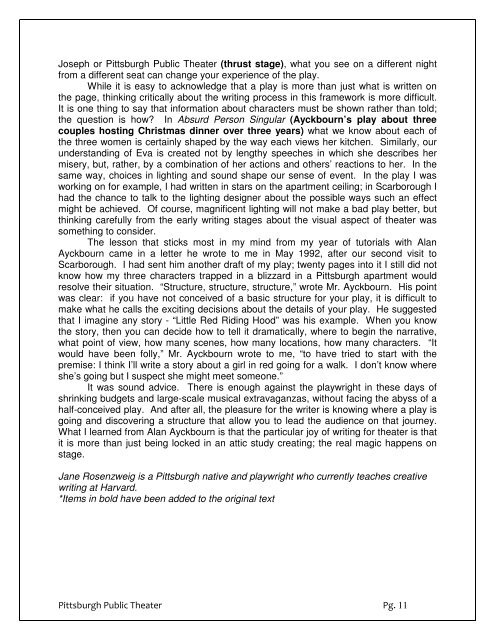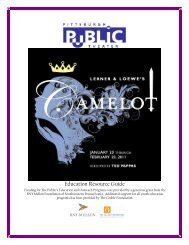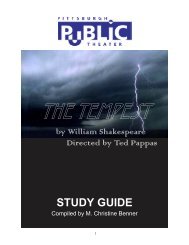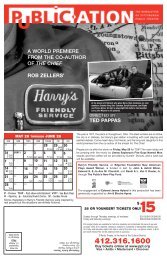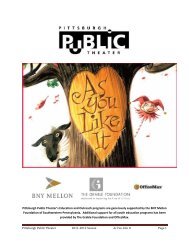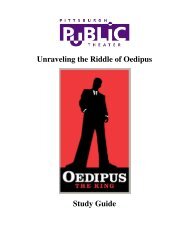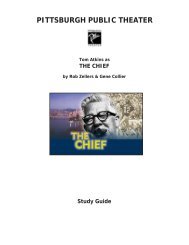Time of My Life by Alan Ayckbourn - Pittsburgh Public Theater
Time of My Life by Alan Ayckbourn - Pittsburgh Public Theater
Time of My Life by Alan Ayckbourn - Pittsburgh Public Theater
- No tags were found...
Create successful ePaper yourself
Turn your PDF publications into a flip-book with our unique Google optimized e-Paper software.
Joseph or <strong>Pittsburgh</strong> <strong>Public</strong> <strong>Theater</strong> (thrust stage), what you see on a different nightfrom a different seat can change your experience <strong>of</strong> the play.While it is easy to acknowledge that a play is more than just what is written onthe page, thinking critically about the writing process in this framework is more difficult.It is one thing to say that information about characters must be shown rather than told;the question is how? In Absurd Person Singular (<strong>Ayckbourn</strong>’s play about threecouples hosting Christmas dinner over three years) what we know about each <strong>of</strong>the three women is certainly shaped <strong>by</strong> the way each views her kitchen. Similarly, ourunderstanding <strong>of</strong> Eva is created not <strong>by</strong> lengthy speeches in which she describes hermisery, but, rather, <strong>by</strong> a combination <strong>of</strong> her actions and others’ reactions to her. In thesame way, choices in lighting and sound shape our sense <strong>of</strong> event. In the play I wasworking on for example, I had written in stars on the apartment ceiling; in Scarborough Ihad the chance to talk to the lighting designer about the possible ways such an effectmight be achieved. Of course, magnificent lighting will not make a bad play better, butthinking carefully from the early writing stages about the visual aspect <strong>of</strong> theater wassomething to consider.The lesson that sticks most in my mind from my year <strong>of</strong> tutorials with <strong>Alan</strong><strong>Ayckbourn</strong> came in a letter he wrote to me in May 1992, after our second visit toScarborough. I had sent him another draft <strong>of</strong> my play; twenty pages into it I still did notknow how my three characters trapped in a blizzard in a <strong>Pittsburgh</strong> apartment wouldresolve their situation. “Structure, structure, structure,” wrote Mr. <strong>Ayckbourn</strong>. His pointwas clear: if you have not conceived <strong>of</strong> a basic structure for your play, it is difficult tomake what he calls the exciting decisions about the details <strong>of</strong> your play. He suggestedthat I imagine any story - “Little Red Riding Hood” was his example. When you knowthe story, then you can decide how to tell it dramatically, where to begin the narrative,what point <strong>of</strong> view, how many scenes, how many locations, how many characters. “Itwould have been folly,” Mr. <strong>Ayckbourn</strong> wrote to me, “to have tried to start with thepremise: I think I’ll write a story about a girl in red going for a walk. I don’t know whereshe’s going but I suspect she might meet someone.”It was sound advice. There is enough against the playwright in these days <strong>of</strong>shrinking budgets and large-scale musical extravaganzas, without facing the a<strong>by</strong>ss <strong>of</strong> ahalf-conceived play. And after all, the pleasure for the writer is knowing where a play isgoing and discovering a structure that allow you to lead the audience on that journey.What I learned from <strong>Alan</strong> <strong>Ayckbourn</strong> is that the particular joy <strong>of</strong> writing for theater is thatit is more than just being locked in an attic study creating; the real magic happens onstage.Jane Rosenzweig is a <strong>Pittsburgh</strong> native and playwright who currently teaches creativewriting at Harvard.*Items in bold have been added to the original text "11


